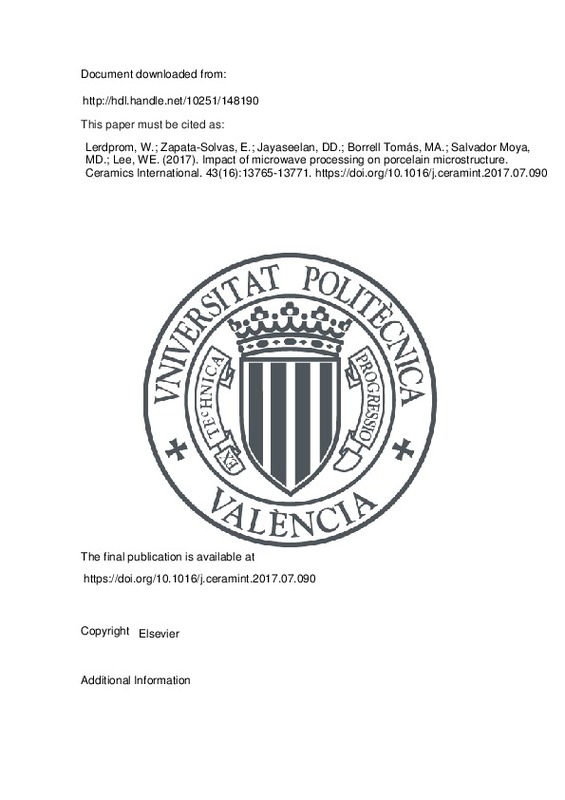JavaScript is disabled for your browser. Some features of this site may not work without it.
Buscar en RiuNet
Listar
Mi cuenta
Estadísticas
Ayuda RiuNet
Admin. UPV
Impact of microwave processing on porcelain microstructure
Mostrar el registro sencillo del ítem
Ficheros en el ítem
| dc.contributor.author | Lerdprom, Wirat
|
es_ES |
| dc.contributor.author | Zapata-Solvas, Eugenio
|
es_ES |
| dc.contributor.author | Jayaseelan, Doni D.
|
es_ES |
| dc.contributor.author | Borrell Tomás, María Amparo
|
es_ES |
| dc.contributor.author | Salvador Moya, Mª Dolores
|
es_ES |
| dc.contributor.author | Lee, William E.
|
es_ES |
| dc.date.accessioned | 2020-07-17T03:32:22Z | |
| dc.date.available | 2020-07-17T03:32:22Z | |
| dc.date.issued | 2017-11 | es_ES |
| dc.identifier.issn | 0272-8842 | es_ES |
| dc.identifier.uri | http://hdl.handle.net/10251/148190 | |
| dc.description.abstract | [EN] Microstructural evolution on sintering of porcelain powder compacts using microwave radiation was compared with that in conventionally sintered samples. Using microwaves sintering temperature was reduced by similar to 75 degrees C and dwell time from 15 min to 5 min while retaining comparable physical properties i.e. apparent bulk density, water absorption to conventionally sintered porcelain. Porcelain powder absorbed microwave energy above 600 degrees C due to a rapid increase in its loss tangent. Mullite and glass were used as indicators of the microwave effect: mullite produced using microwaves had a nanofibre morphology with high aspect ratio (similar to 32 +/- 3:1) believed associated with a vapour-liquid-solid (VLS) formation mechanism not previously reported. Microwaves also produced mullite with different chemistry having similar to 63 mol% alumina content compared to similar to 60 mol% alumina in conventional sintered porcelain. This was likely due to accelerated Al+3 diffusion in mullite under microwave radiation. Liquid glass was observed to form at relatively low temperature (similar to 900-1000 degrees C) using microwaves when compared to conventional sintering which promoted the porcelains ability to absorb them. | es_ES |
| dc.description.sponsorship | W. Lerdprom acknowledges Imperial College London funding no. MMRE_PG54200. A. Borrell acknowledges the Spanish Ministry of Economy and Competitiveness for her Juan de la Cierva-Incorporacion contract (IJCI-2014-49839). | es_ES |
| dc.language | Inglés | es_ES |
| dc.publisher | Elsevier | es_ES |
| dc.relation.ispartof | Ceramics International | es_ES |
| dc.rights | Reserva de todos los derechos | es_ES |
| dc.subject | Porcelain | es_ES |
| dc.subject | Aluminosilicate | es_ES |
| dc.subject | Mullite | es_ES |
| dc.subject | Microwave sintering | es_ES |
| dc.subject | Field assisted sintering technique | es_ES |
| dc.subject.classification | CIENCIA DE LOS MATERIALES E INGENIERIA METALURGICA | es_ES |
| dc.title | Impact of microwave processing on porcelain microstructure | es_ES |
| dc.type | Artículo | es_ES |
| dc.identifier.doi | 10.1016/j.ceramint.2017.07.090 | es_ES |
| dc.relation.projectID | info:eu-repo/grantAgreement/MINECO//IJCI-2014-49839/ | es_ES |
| dc.relation.projectID | info:eu-repo/grantAgreement/Imperial College London//MMRE_PG54200/ | es_ES |
| dc.rights.accessRights | Abierto | es_ES |
| dc.contributor.affiliation | Universitat Politècnica de València. Instituto de Tecnología de Materiales - Institut de Tecnologia de Materials | es_ES |
| dc.contributor.affiliation | Universitat Politècnica de València. Departamento de Ingeniería Mecánica y de Materiales - Departament d'Enginyeria Mecànica i de Materials | es_ES |
| dc.description.bibliographicCitation | Lerdprom, W.; Zapata-Solvas, E.; Jayaseelan, DD.; Borrell Tomás, MA.; Salvador Moya, MD.; Lee, WE. (2017). Impact of microwave processing on porcelain microstructure. Ceramics International. 43(16):13765-13771. https://doi.org/10.1016/j.ceramint.2017.07.090 | es_ES |
| dc.description.accrualMethod | S | es_ES |
| dc.relation.publisherversion | https://doi.org/10.1016/j.ceramint.2017.07.090 | es_ES |
| dc.description.upvformatpinicio | 13765 | es_ES |
| dc.description.upvformatpfin | 13771 | es_ES |
| dc.type.version | info:eu-repo/semantics/publishedVersion | es_ES |
| dc.description.volume | 43 | es_ES |
| dc.description.issue | 16 | es_ES |
| dc.relation.pasarela | S\350890 | es_ES |
| dc.contributor.funder | Imperial College London | es_ES |
| dc.contributor.funder | Ministerio de Economía y Competitividad | es_ES |







![[Cerrado]](/themes/UPV/images/candado.png)

